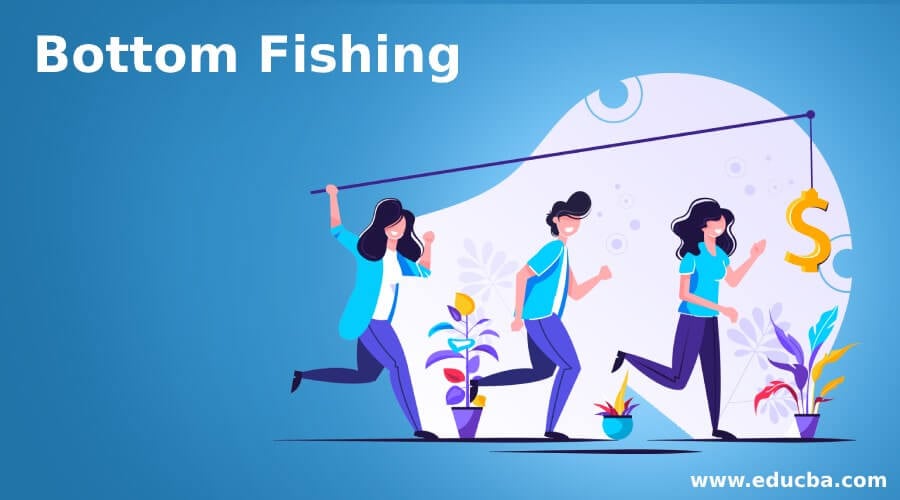Updated July 18, 2023

Definition of Bottom Fishing
Bottom fishing is a short-term price action strategy where the investor buys securities that have observed a sudden fall in their prices over a very short period, with or without any big fundamental change in the company’s prospects.
It is a high-risk strategy that intends to make a quick short-term profit and may or may not be supported entirely by technical and fundamental indicators when investing. Those who undertake the bottom fishing strategy are also known as bottom fishers. The primary rationale for undertaking bottom fishing is the belief that investors expect a reversal in the short-term price of the security, considering it undervalued.
Explanation
The bottom fishing strategy is like catching a falling knife. It is a high-risk, high-return strategy suitable for those investors who understand the risks associated with it. It involves taking a contra bet on security which has observed a steep fall in its price, which can be based on fundamental analysis, technical analysis, or maybe a combination of both.
Renowned fund managers and value investors apply bottom fishing, denoted as value investing, in security selection when undertaken with fundamental analysis.
Examples of Bottom Fishing
Bottom-fishing examples are common in stock markets and are evident across multiple asset classes. The recent crash in the NASDAQ in March 2020 due to the coronavirus pandemic led to a substantial price fall. Many investors undertook bottom fishing by buying blue chip stocks such as Facebook, Apple, etc., as they expected that fall in the price of such securities is overdone and short-time price reversal expectation which can be seen with the way Nasdaq has hit its lifetime highs.
Another example of an investor buying airline stocks in the current scenario of the coronavirus pandemic, where the whole aviation and hospitality industry is facing economic depression, is an example of bottom fishing.
Let’s undertake one practical example as well to understand Bottom Fishing better.
ABC Limited purchased the stock of reliance industries limited when the stock price fell from $100 on 12 feb 2020 to $43 on 31st March 2020. According to ABC Limited, the impact on the price is beyond the stock’s intrinsic value, which has made it highly undervalued, and it expects the price to retrace and make a reversal. After hitting the low $35 the price of stock reversed and reached a price of $60 on 05 June 2020, allowing ABC Limited to gain $17 per share in a very short period. This short-term profit of $17 per share is an example of bottom fishing.
Techniques of Bottom Fishing
Major techniques adopted while undertaking bottom fishing can be broadly classified into two techniques:
- Technical Analysis: Under this, investors buy those securities which have fallen fast from their highs and are at oversold levels with their relative strength indicator (RSI). When supported by volume and other long-term trend analyses, such Analysis can instill more confidence in the investor to do bottom fishing.
- Fundamental Analysis: Under this, the investor undertakes value investing, whereby the rationale is the fall in prices doesn’t justify the security’s intrinsic value. The price fall may be due to bad quarter results or a temporary lockdown in business. Those undertaking bottom fishing using fundamental analysis usually buy from a medium-term perspective.
Advantages of Bottom Fishing
Bottom Fishing offers multiple advantages:
- It offers a greater reward in a short period. If the security makes a reversal, normal investments are comparatively slower in terms of reward potential compared to the strategy.
- It can be supported by technical setups where security is deemed oversold on multiple time frames due to heavy selling without any underlying change in its fundamentals and business prospects.
Disadvantages of Bottom Fishing
Despite the benefits, Bottom fishing suffers from multiple disadvantages, namely:
- It is a high-risk strategy unsuitable for all types of investors and contravenes the momentum investing strategy.
- Sometimes, when opting for the bottom fishing strategy, we have observed that such securities take longer than normal investing to recover, leading to a non-attainment of the purpose.
How Bottom Fishing Differs from Momentum Investing Strategy?
The two strategies are used in conjunction at times; however, the two have some key differences which make them apart.
Key differences are enumerated below:
| Basis | Bottom Fishing Strategy | Momentum Investing Strategy |
| Definition | It involves buying securities that have experienced a substantial decline in their prices over a short period. | Momentum Investing involves buying securities regularly, making new highs, and selling those regularly, making new lows. |
| The Premise of the Strategy | It is based on the premise that a fall in value doesn’t justify the intrinsic value (which is more), and the price should reverse back. | It is purely based on technical setup and has nothing to do with intrinsic value. Investors opting for Momentum Investing are purely guided by technical setup. |
| Buy-sell Mechanism | It is based on the strategy of Buy low, sell high. | It is based on Buy High, Selling even high (Uptrend securities), and Selling low and buying even lower (Downtrend securities). |
Conclusion
Bottom Fishing is among the many stock selection strategies investors opt for in the Securities Market. The strategy involves investors buying beaten-down stocks and finding their origin in Contra Investing. Bottom Fishing can be highly rewarding for investors if done correctly and achieved the stated result; however, the strategy carries a higher risk than other security selection strategies. It is ideal for those searching for bottom fishing to use sophisticated market data tools to better undertake technical and fundamental analysis before placing their bets to have a better probability of making handsome gains.
Recommended Articles
This is a guide to Bottom Fishing. Here we discuss the definition and techniques of bottom fishing along with advantages and disadvantages. You may also have a look at the following articles to learn more –

